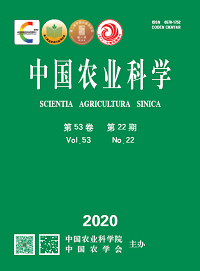【Objective】The objective of this study is to obtain mutant strains of Trichoderma afroharzianum ACCC 33109 with high yield of inhibitory volatile organic compounds (VOCs) and analyze the carbon utilization mechanism.【Method】Mutant strains were obtained through protoplast ultraviolet mutagenesis of wild-type ACCC 33109 and screened by sandwiched Petri plate method. The wild type and mutant strains MU153, MU792 were then subjected to carbon utilization analysis using Omnilog phenotype microassays.【Result】A total of 828 mutant strains were obtained by 2.0 min ultraviolet mutagenesis, with the lethality rate of 76.63%. Among them, 30 mutants showed higher inhibitory activities against Fusarium oxysporum than the wild type. MU153 showed the highest inhibitory rate (53.86%), which was 16.68% higher than that of the wild type, while the inhibitory rate of MU792 was as low as 15.83%. The pot experiments showed that both ACCC 33109 and MU153 had the effects of promoting cucumber growth and preventing cucumber fusarium wilt. Compared with ACCC 33109, the relative control effect of MU153 on cucumber fusarium wilt increased by 15.88%, which was as high as 89.69%. UV mutagenesis caused changes in the morphologies of colony, hypha, and conidiogenous structures and metabolic capacity to utilize carbon sources of the mutants. Compared with ACCC 33109, the mycelia of MU153 grew rapidly and densely, became flocculent, and pigment was produced, while the mycelia of MU792 grew slowly and loosely, and the colony color changed from green to white at the late stage. The sizes of conidia and pedicels of MU153 and MU792 increased, and the base width of the conidia decreased. Moreover, MU153 had a higher metabolic capacity for 46 substances in FF plate, including D-arabinol, diethanolamine, maltose, arbutin, cellobiose and α-D-glucose, but less active on the other 50 substances, such as 4-hydroxyphenylacetic acid, succinic acid, succinamic acid, glucogen, bromosuccinic acid and L-threonine. MU792 had a higher metabolic capacity for 27 substances in FF plate, including γ-hydroxybutyric acid, glucose-1-phosphate, β-hydroxybutyric acid, D-methyl lactate, D-sorbitol and propanamide, and lower metabolic capacity on the other 69 substances, including succinamic acid, N-acetyl-D-glucosamine, 4-hydroxyphenylacetic acid, sebacic acid, Tween-80, D-saccharic acid. α-D-Glucose was the most favorable substrate for antifungal VOCs production. With α-D-glucose as the carbon source, the inhibitory rates of VOCs of ACCC 33109, MU153 and MU792 to F. oxysporum were 48.08%, 56.17% and 40.94%, respectively. 【Conclusion】T. afroharzianum MU153 has the capability of producing a large amount of inhibitory VOCs, favors α-D-glucose for the highest yield of VOCs, and thus represents a great candidate of biocontrol agent.









